Dive Details
Location
Logged dive number
1730
Date
Saturday 7 December 2019
Time
1:53pm - 3:27pm
Buddy
Karina Teuma, Robin Weber
Seas
Strong current at times and mild surge
Visibility
5 to 10 metres
Duration
94 minutes
Surface interval
Maximum depth
14.5 m
Average depth
11.4 m
Water temperature
18.5°C
Dive Profile from Citizen Hyper Aqualand
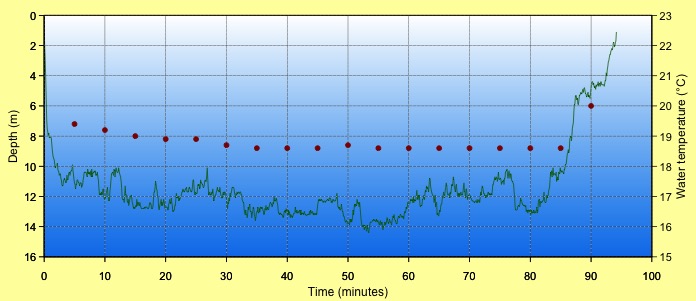
Tides at Botany Bay AEDT
Note that tides at dive site may vary from above location.
High
5:47am
1.39m
Low
11:51am
0.70m
High
5:47pm
1.35m
Details
Today I was taking Karina and Robin to show them some of the cool stuff that The Steps has to offer. They both dive here often but miss out on many of the organisms that can be seen.
It was still quite close to low tide so we stepped down from the platform, waded out a bit, and put our fins on. Once we were ready, we descended to the rocks and then swam over the kelp to the sand line. The visibility was 5 to 10 metres although there was fine particulate matter in the water. There was not much surge but the current was quite strong despite the small difference in the tides. The water temperature was between 18 and 19°C. We turned right and headed towards Big Rock.
We followed the sand line past the rocks in front of the exit and on to the large rock on the sand line where the seahorses were last year. Here we bumped into Leah and John. Leah was photographing a small school of Striped Catfish (probably the remnants of the large school from last week) and John had found an orange Red-Fingered Anglerfish on the underside of the large rock. I looked on the next rock for the smaller orange Red-fingered Anglerfish that I'd seen last Saturday (using Mike's directions) but I was not able to find it. I did find a Reaper Cuttlefish. After Leah and John had finished with the larger anglerfish, I took some photographs, too. I don't believe it is the same one from last week. Karina also took some photographs of the anglerfish.
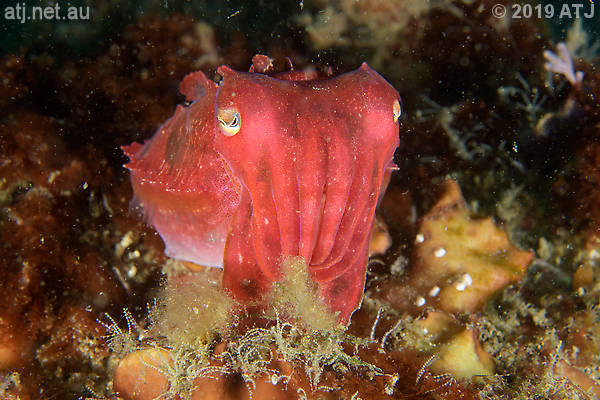
Reaper Cuttlefish, Sepia mestus. 10.5m.

Red-fingered Anglerfish, Porophryne erythrodactylus. 11.9m.
We continued along the sand line to Pipefishes Hole. I looked in the hole but could not see any pipefishes. "Teardrop", the male Weedy Seadragon, was near the kelp just past Pipefishes Hole. His eggs are developing. I took some photographs and while Karina was photographing him I swam up to Di's Rock but found nothing of interest.
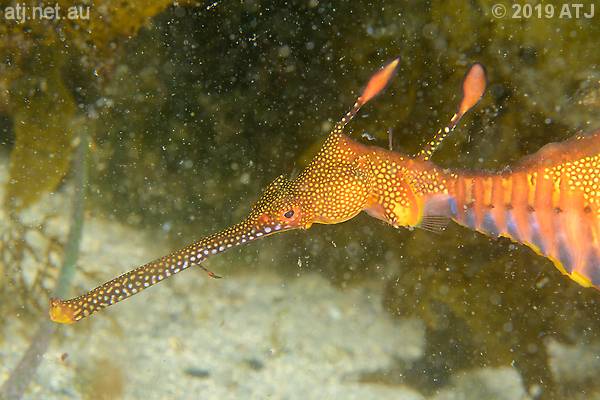
Weedy seadragon, Phyllopteryx taeniolatus, (Teardrop). 12.8m.
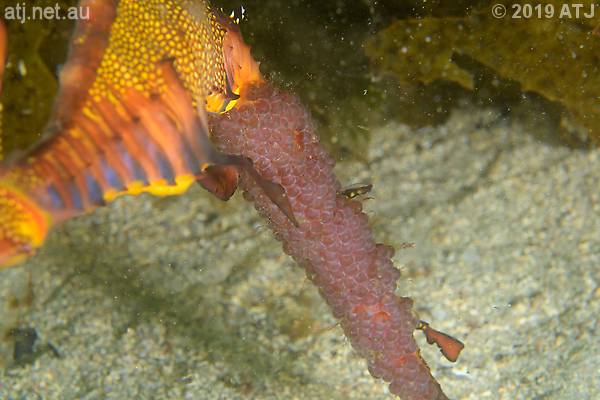
Eggs on the tail of a male Weedy seadragon, Phyllopteryx taeniolatus, (Teardrop). 12.7m.
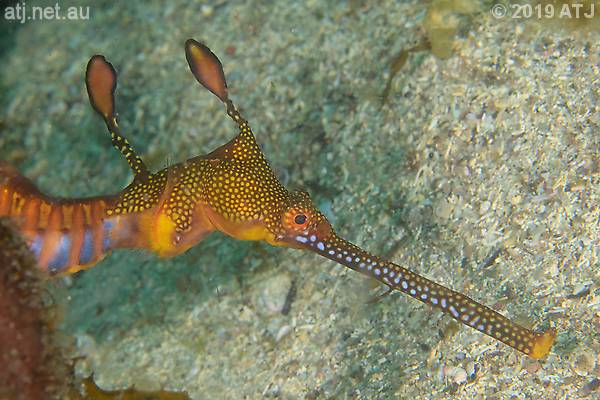
Weedy seadragon, Phyllopteryx taeniolatus, (Teardrop). 12.8m.
I dropped back to the others on the sand line and we swam slowly towards Little Big Rock. The current was quite strong and it made the going tough.
We peeled up from the sand line at Little Big Rock to the large rock with the seahorses. I spotted "Skye" on the lower rock hanging on to a sponge. I took some photographs and pointed her out to the others. I then went looking for the males. I found "David" low down between the white honeycomb sponge and the sea tulips. I found "George" even lower on the other side of the honeycomb sponge. I pointed them out to Robin who then showed Karina.

Female Pot-Bellied Seahorse, Hippocampus abdominalis, ("Skye"). 12.1m.
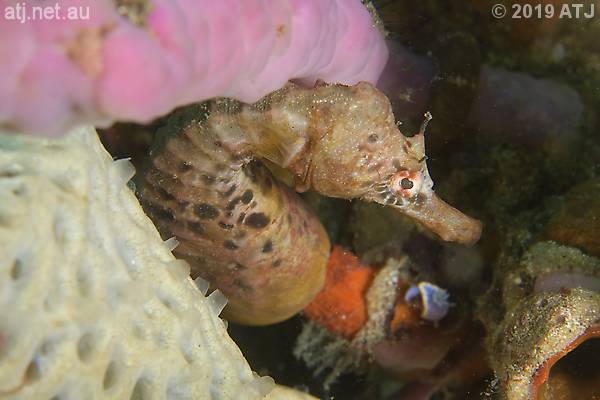
Male Pot-bellied Seahorse, Hippocampus abdominalis, ("David"). 11.7m.

Male Pot-bellied Seahorse, Hippocampus abdominalis, ("George"). 11.7m.
We headed towards the basket star. I looked for the black Painted Anglerfish along the way but could not find it. I took photographs of the basket star when we got there and pointed it out to the others.

Basket star, Astrosierra amblyconus. 11.8m.
We swam down to near Diversity Rock. I looked for the Miamira magnifica nudibranch but I was not able to find it. This is the first time in weeks that I have not seen it.
We continued to Sponge Hollow. I was hoping that at least we'd see the Miamira magnifica nudibranch that Mike had found last week but I couldn't find it either.
We dropped down to the pair of pink pygmy pipehorses. I found the male (IL2019100601) straight away. I took some photographs and pointed him out to the others. I then looked around for the female and finally found her (IL2019100503) on top of the rock. I pointed her out.
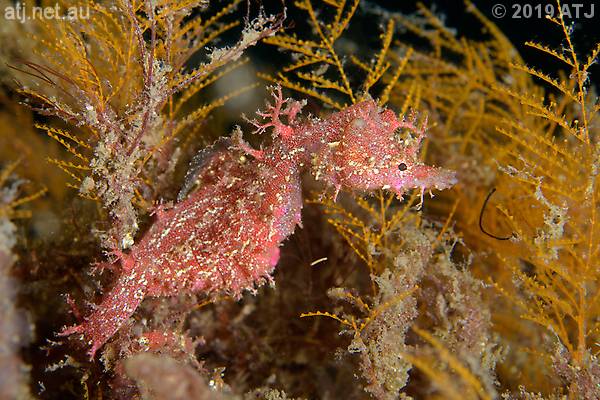
Male Sydney Pygmy Pipehorse, Idiotropiscis lumnitzeri, (IL2019100601). 13.1m.

Female Sydney Pygmy Pipehorse, Idiotropiscis lumnitzeri, (IL2019100503). 12.9m.
We swam past the rock where the one-eyed seahorse had been last year to the rock where the large orange Red-fingered Anglerfish with eggs had been. This time I knew he had eggs so I looked for them and could see them. I tried to get some photographs but it wasn't easy to get in close and get light into the hole. I left Karina and Robin with the anglerfish and dropped down to the Doughboy Scallop. When I took some photographs I realised I still had the focus point shifted from the pygmy pipehorses (and my anglerfish photographs would be off). I headed back to the anglerfish as Karina and Robin were still. After Karina finished taking photographs, I took some more.
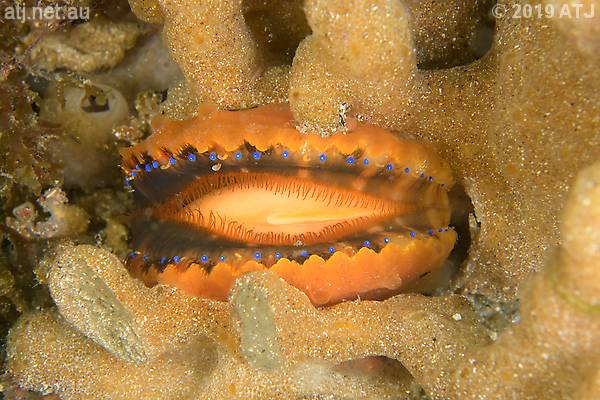
Doughboy Scallop, Mimachlamys asperrima. 13.8m.
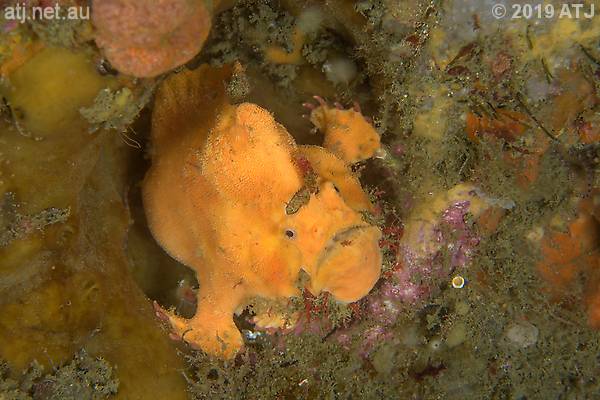
Red-fingered Anglerfish, Porophryne erythrodactylus. 12.3m.
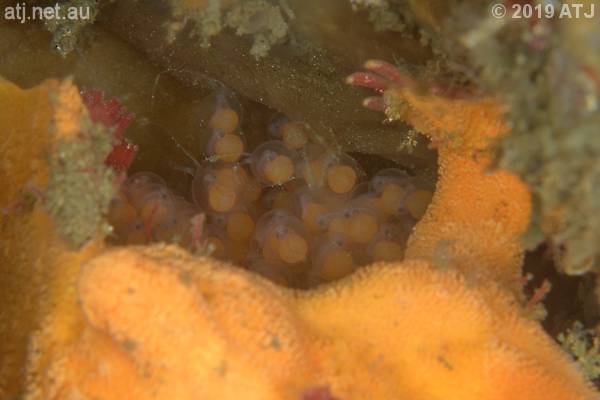
Eggs being guarded by a Red-fingered Anglerfish, Porophryne erythrodactylus. 12.2m.
We headed back down to the Doughboy Scallop and I pointed it out. I then went to the long rock and looked for the pygmy pipehorses there. The strong current made it difficult. I wasn't able to find either of them.
When Karina and Robin caught up, we continued to Big Rock. I looked around in the finger sponges for "Ouz", the yellow White's Seahorse. I was not able to find her.
We turned and headed back towards The Steps. The current was with us so the going was easy. We swam back via Sponge Hollow and I had another look for the Miamira magnifica nudibranch. I still couldn't find it.
We continued on to Diversity Rock and I looked unsuccessfully for the smaller of the Miamira magnifica nudibranchs.
I had another look for the black Painted Anglerfish as we swam on to the seahorses. All three seahorses were in the same spots they were on our way out. As I was photographing the seahorse, Robin indicated that he and Karina were heading for the exit. I stayed with the seahorses and then finished the dive on my own.
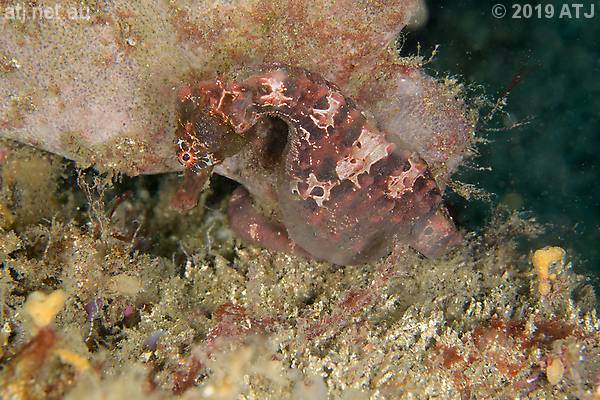
Female Pot-Bellied Seahorse, Hippocampus abdominalis, ("Skye"). 12.3m.
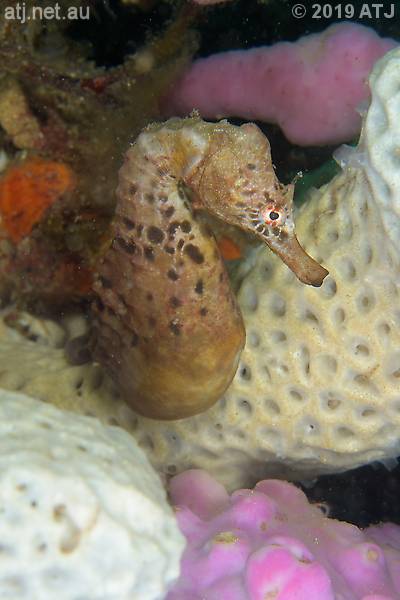
Male Pot-bellied Seahorse, Hippocampus abdominalis, ("David"). 12m.
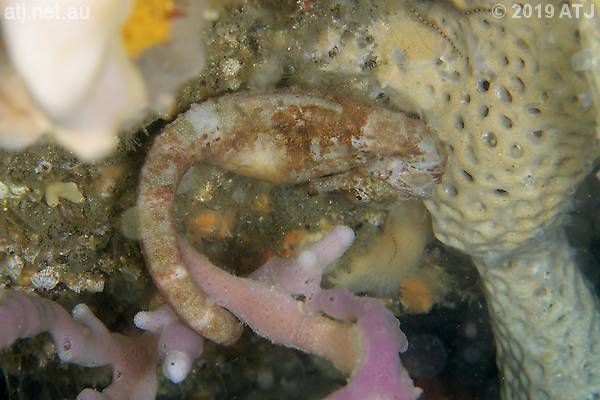
Male Pot-bellied Seahorse, Hippocampus abdominalis, ("George"). 11.8m.
I swam along the top of the reef towards Di's Rock hoping to find some more Anglerfishes. All I found was a Reaper Cuttlefish.
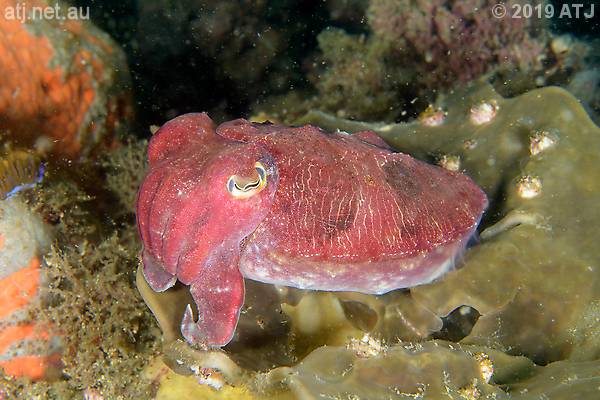
Reaper Cuttlefish, Sepia mestus. 10.9m.
At Di's Rock I dropped back down to the sand line and Pipefishes Hole. I still could not see any pipefishes in the hole. I took some more photographs of "Teardrop" before continuing.
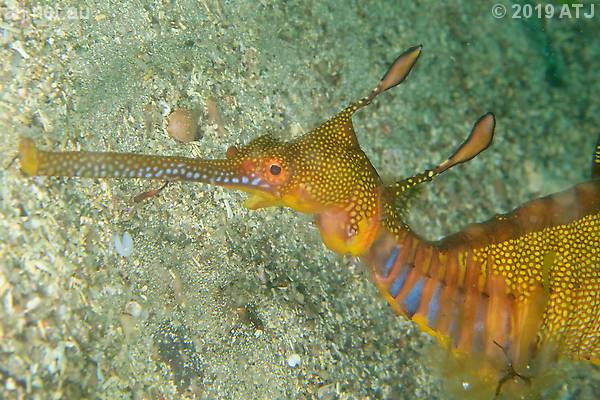
Weedy seadragon, Phyllopteryx taeniolatus, (Teardrop). 13m.
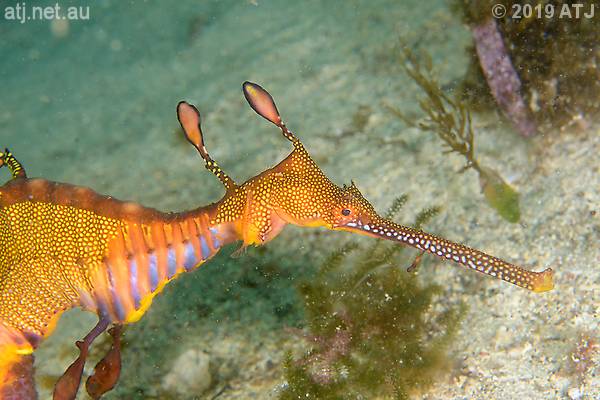
Weedy seadragon, Phyllopteryx taeniolatus, (Teardrop). 13.1m.
I stayed along the sand line to the large rock where the seahorses had been last year. The large orange Red-fingered Anglerfish was still on the underside of the rock. I took some photographs.

Red-fingered Anglerfish, Porophryne erythrodactylus. 12.1m.
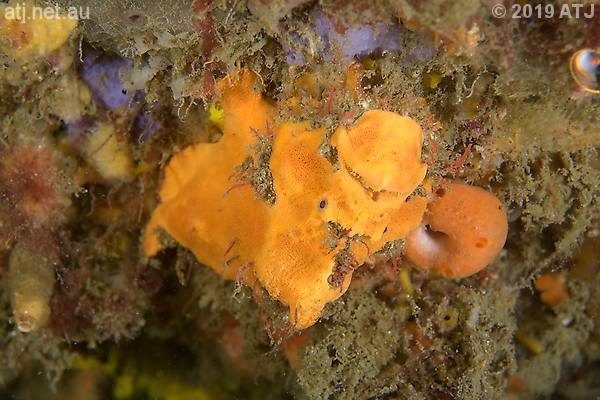
Red-fingered Anglerfish, Porophryne erythrodactylus. 11.8m.
I headed over the kelp to the rocks in front of the entry/exit. I looked around for anglerfishes but found nothing. I swam to the boulders and then ascended to Split Rock and started my safety stop. I finished my safety stop and swam underwater to the exit. The tide was still low but it was easy to get out onto the platform.
Camera gear
Camera
Nikon D500
Lens
Nikon AF-S Micro Nikkor 60mm f/2.8G ED
Housing
Ikelite 6812.5
Lens port
Ikelite Flat Port 5502.41
Strobe(s)
2 x Ikelite SubStrobe DS161